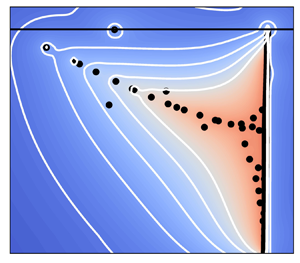Article contents
Stability and receptivity analyses of mixed convection in unstably stratified horizontal boundary layers
Published online by Cambridge University Press: 17 April 2023
Abstract

A linear stability analysis is employed to investigate thermal effects in shear flows. The cases analysed consist of unstably stratified horizontal boundary layers under a mixed convection regime, where forced and free convection mechanisms compete. Governing equations are given by the incompressible Navier–Stokes equations with the Oberbeck–Boussinesq approximation, where the base flow comes from their boundary layer approximation. Modal and non-modal analyses are used to investigate the behaviour of small-amplitude disturbances superposed to this base flow. An evaluation of the inertial, shearing and buoyancy mechanisms in the mixed convection boundary layer stability is performed through variations in the Reynolds, Prandtl and Richardson numbers. On the one hand, the spectra lead to the parametric conditions for the time-asymptotic onset of instability, which is still caused by Tollmien–Schlichting (TS) waves as in the traditional Blasius case. However, thermal effects have a destabilizing effect on them, more so for liquids than gases. On the other hand, the pseudospectra obtained from a resolvent analysis indicate the existence of transient growth at this same onset. However, contrary to the traditional Blasius case, thermal effects cause it to be dominated by the continuous frequency spectrum instead of the discrete TS modes. In order to elucidate this qualitative change, a componentwise input–output analysis is employed to quantify the receptivity to specific external disturbances. It shows that thermal effects directly impact the conversion of thermal to kinetic linear disturbance energy, causing a strong amplification of the flow response due to the non-normality of the linear operator. Results reveal that heating from below causes the forcing and response modes of the input–output analysis to have a free-stream spatial support due to non-modal excitation of the continuous spectrum. Such a behaviour suggests that the unstably stratified boundary layer is susceptible to free-stream thermal disturbances, which can potentially impact bypass transition.
- Type
- JFM Papers
- Information
- Copyright
- © The Author(s), 2023. Published by Cambridge University Press
References
- 4
- Cited by





